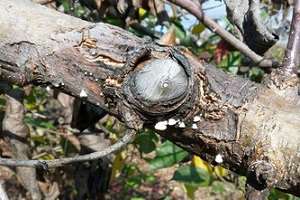Sanitation is the best offense for disease management, especially when it comes to canker removal.

It’s December and many leaves are still on the trees – it’s as if Mother Nature isn’t sure if she’s coming or going. Once those leaves finally fall off, folks will be keen to get out and begin pruning. As folks start to prune their trees, it is important to also remove any cankers found. Cankers harbor pathogens, such as bacteria or fungal spores, which can cause problems for the following season.
In continuing with the theme from last month’s article about wrapping up the 2016 season by being proactive about disease management for the 2017 season, this article will discuss canker removal. In January 2016, I wrote an article for Fruit Times about managing fire blight cankers during the winter season. Although this was specific for fire blight canker removal, the same principles apply regardless of how the canker developed.
A fresh review as you begin pruning your trees
Cankers are localized dead areas of bark and underlying wood on twigs, branches, and trunks. Cankers can be caused by living things (fungi, bacteria) or nonliving things (hail, high or low temperature, injury). For a canker to occur, a wound (entry point) is needed. It is important to remove cankers because they serve as the overwintering source for fungal spores (bitter, brown rots) and bacteria (fire blight) that cause diseases during the season, as well as create a nice environment for other fungi you do not want hanging around, such as fungi causing fruit rot (white, black rots).
To ensure you’re pruning out all cankers in your orchard, it make take a couple walk-throughs, under different lighting of the day to see them all. The cankered wood has distinct characteristics:
- Localized roughened or cracked bark, especially around wounds, branch stubs, old pruning cuts.
- Bark that is darker than the surrounding bark tissue, which is healthy.
- Roughened/darkened areas appearing “wrinkled” or “sunken.”
- Small pimple-like fungal spore forming structures – may be red, dark brown, or black (depending on the fungus).
- Wood-decay fungi, which attack dead wood and often appear as white protrusions growing out of the bark.
- Nectria twig blight or Nectria canker (wound invader pathogen – will not attack healthy wood) will often take advantage of cankers and will produce bright orange spores on the canker.
- In stone fruit trees, gummosis is often associated with cankered wood.
When you see cankers, it is best to prune 6 – 12 inches from the canker’s visible edge. If fire blight cankers are established in the trunk of the tree or infected trees are very young (newly planted – 3 years old), it is best to remove the entire tree. It is important to be mindful of stone fruit trees that have had a history of brown rot. Cankers can arise due to blossom blight infections or severe fruit rot infections. When it comes to cankered wood, it is best to burn all tissue when possible to ensure destroying any overwintering bacteria or fungi.
Source: psu.edu